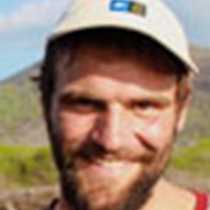Early in the morning we woke up in search for cetaceans all along the Bolivar Canal between Isabela and Fernandina Islands. It was a misty-cloudy day and it didn’t seem like it was a day to spot any large marine mammals, but the weather had spoken falsely. All the sudden a pod of around 50 false killer whales showed up and were all over the ocean around the National Geographic Islander. We started our day with this amazing highlight, since it’s been several years since we last saw these cetaceans. At some point we were even able to see groups of 10 to 15 of them at a time.
After enjoying the magical show put up by the false killer whales, we headed for breakfast.
Soon after going down the nose of the sea horse-shaped island, we crossed the equator line and had an interesting celebration, where some of our guests became shellbacks for the first time. A Zodiac ride was offered next, to explore the coast of Isabela Island. As soon as we got on the Zodiacs, we spotted two whale spews about half a mile from the ship. We managed to approach the whales and we could identify them as two Bride’s whales (mother & calf), and they came not far away from the Zodiac several times.
On our way back to the coast, we spotted three ocean sunfish (the largest bone fish on the planet). These large fish were swimming around the Zodiac and we were able to take a good look at them; while some others usually show their dorsal fin out the water, these were actually performing a great show for us. We rode our Zodiacs along the coast of Punta Vicente Roca at Isabela, where several blue-footed boobies were seen, many Nazca boobies and, for the first time this week, we saw the endemic flightless cormorants. This is a very productive area, so productive that we even found plenty of Pacific green sea turtles basking on the surface of the ocean and resting in the bottom of the protected cove, where we later on had the opportunity to enjoy a fascinating snorkeling outing. Snorkeling here was just magical, at one point I had close to 10 turtles all around me. I just floated and gently found my way out, as they don’t really mind the fact that humans are swimming next to them.
During the afternoon, we visited Fernandina (the youngest of the Galapagos). We had a dry landing and once on land we were welcomed by hundreds of marine iguanas piled up onto each other to retain body heat. The Galapagos hawks were seen flying over the area in search of some pray. The Galapagos flightless cormorants were nesting on the smooth lava fields. Many of them were close to the path for us to get some nice detailed photos and get to learn more about the evolutionary trade-offs these birds made to adapt to the Galapagos environment. We closed the day with some cocktails under a beautiful sunset watched from the sky deck of the National Geographic Islander.








